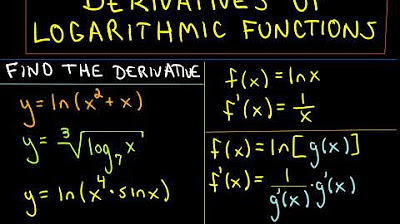Zain does Partial Fractions
TLDRIn this educational video, Zayn Walker demonstrates the process of integration by partial fractions. Starting with the equation \( \frac{5 - x}{(2x - 1)(x + 1)} \), he factors the denominator and sets up the partial fraction decomposition. By plugging in specific values for x to solve for constants a and b, he finds \( a = 3 \) and \( b = -2 \). Walker then integrates the simplified expression, resulting in \( \frac{3}{2} \ln|2x - 1| - 2\ln|x + 1| \), offering a concise explanation suitable for students preparing for exams.
Takeaways
- 📝 The video is about teaching the method of integration by partial fractions.
- 🔍 The first step is to factor the denominator of the given integral equation.
- 📐 The given integral is of the form (5 - x) / ((2x - 1)(x + 1)) which is factored into (5 - x) / [(x - 1/2)(2x + 1)].
- 📈 The next step involves setting up the equation for partial fractions: A / (2x - 1) + B / (x + 1).
- 🔄 Multiply the entire equation by the denominator to simplify and find the values of A and B.
- 📌 To find B, substitute x = -1 into the simplified equation, resulting in B = -3.
- 📌 To find A, substitute x = 1/2 into the simplified equation, resulting in A = 3.
- 📚 After finding A and B, rewrite the integral with the identified constants.
- 📝 The integral is then rewritten as 3 / (2x - 1) - 2 / (x + 1).
- 🧮 The final step is to integrate each term separately, resulting in 3/2 * ln|2x - 1| - 2 * ln|x + 1|.
- 📑 The final answer is left as an indefinite integral, without applying limits for a definite integral.
Q & A
What is the first step in solving an integral by partial fractions according to the video?
-The first step is to factor the denominator of the equation.
How is the denominator factored in the example provided?
-The denominator is factored into (2x - 1)(x + 1).
What form does the equation take after factoring the denominator?
-The equation becomes 5 - x over (2x - 1)(x + 1) equals A over (2x - 1) plus B over (x + 1).
What is the next step after rewriting the equation with partial fractions?
-The next step is to multiply both sides of the equation by the common denominator, (2x - 1)(x + 1).
How do you determine the values of A and B?
-You determine the values of A and B by plugging in values for x that simplify the equations. For example, setting x = -1 to solve for B and x = 1/2 to solve for A.
What is the value of B when x = -1?
-When x = -1, B is determined to be -2.
What is the value of A when x = 1/2?
-When x = 1/2, A is determined to be 3.
How is the original integral expressed with the determined values of A and B?
-The original integral is expressed as the integral of (3/(2x - 1)) - (2/(x + 1)) dx.
What is the result of integrating the terms separately?
-The result of integrating the terms separately is 3/2 ln|2x - 1| - 2 ln|x + 1|.
What should be done if the integral is definite?
-If the integral is definite, you should plug in the upper and lower bounds for x to find the actual value.
Outlines
📚 Introduction to Partial Fractions Integration
Zayn Walker begins a tutorial on partial fractions integration with a friendly greeting to the audience. He introduces the concept by explaining the importance of factoring the denominator of the given integral equation, which in this case is '5 - x' over '2x - 1' and 'x + 1'. He then demonstrates the setup for the partial fraction decomposition by multiplying the equation by the factored denominator to simplify the process of finding the constants 'a' and 'b'.
Mindmap
Keywords
💡Integration
💡Partial Fractions
💡Factor
💡Equation
💡Integral
💡Multiply
💡Cancel Out
💡Coefficients
💡Plug In
💡Natural Logarithm
💡Absolute Value
Highlights
Introduction to the process of integration by partial fractions.
Writing down the equation and factoring the denominator.
Factored form of the denominator: (5 - x)(2x - 1)(x + 1).
Multiplying the equation by the denominator to simplify.
Setting up the equation for partial fractions: A/(2x - 1) + B/(x + 1).
Multiplying through by the denominator to eliminate fractions.
Rewriting the equation as 5 - x = A(x + 1) + B(2x - 1).
Choosing values for x to solve for A and B.
Solving for B by setting x = -1.
Finding B = -2 from the equation 6 = B(-3).
Solving for A by setting x = 1/2.
Calculating A from the equation 9/2 = A(3/2).
Determining A = 3 from the simplified equation.
Substituting A and B back into the original integral.
Setting up the integral of 3/(2x - 1) - 2/(x + 1).
Integrating the partial fractions to get the final answer.
Final answer: 3/2 ln|2x - 1| - 2 ln|x + 1|.
Explanation that the process is complete and the integral is integratable.
Note on handling definite integrals by plugging in values for x.
Conclusion and encouragement for the test.
Transcripts
5.0 / 5 (0 votes)
Thanks for rating:





